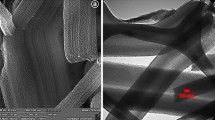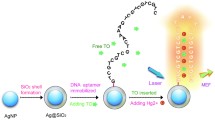Abstract
A new adeninecarboxamide ligand, N-(9 H-purin-6-yl) pyridine-2-carboxamide (H2pzac) has been synthesized by a green chemistry method using tetrabutylammunium bromide (TBAB) ionic liquid as an environmentally friendly reaction medium. The H2pzac ligand was anchored on modified SBA-15-Cl and utilized for detection of Hg2+ in aqueous solution. The as-constructed SBA-15@Hpzac sensor shows a high specific surface area as well as pore volume of 250 m2/g and 0.54 cm3/g, respectively. The fluorescence assessment indicated that the designed SBA-15@Hpzac sensor presented highly sensitive and selective behavior to Hg2+ ion over different cations including Zn2+, Ni2+, Co2+, Cu2+, Mn2+, Pb2+, Ba2+, Mg2+, Ca2+, Na+, Fe3+, Fe2+, Al3+, Cd2+ and K+. The fluorescence response of the SBA-15@Hpzac sensor for selective detection of Hg2+ ion is excellent with detection limit (LOD) of 1.07 × 10− 6 M. The application of the SBA-15@Hpzac sensor in determination of Hg2+ ions in two real water samples was also investigated.













Similar content being viewed by others
References
A. Badiei, B.V. Razavi, H. Goldooz et al., A novel fluorescent chemosensor assembled with 2,6-bis(2-benzimidazolyl)pyridine-functionalized nanoporous silica-type SBA-15 for recognition of Hg2+ ion in aqueous media. Int. J. Environ. Res. 12, 109–115 (2018). https://doi.org/10.1007/s41742-018-0075-1
J. Wang, X. Zhang, H.B. Liu et al., Aggregation induced emission active fluorescent sensor for the sensitive detection of Hg2+ based on organic–inorganic hybrid mesoporous material. Spectrochim. Acta Part A Mol. Biomol. Spectrosc. 227, 117585 (2020). https://doi.org/10.1016/j.saa.2019.117585
E.F. Aboelfetoh, M.E. Zain Elabedien, E.Z.M. Ebeid, Effective treatment of industrial wastewater applying SBA-15 mesoporous silica modified with graphene oxide and hematite nanoparticles. J. Environ. Chem. Eng. 9, 104817 (2021). https://doi.org/10.1016/j.jece.2020.104817
A. Shahat, S. Trupp, Sensitive, selective, and rapid method for optical recognition of ultra-traces level of hg(II), ag(I), au(III), and pd(II) in electronic wastes. Sens. Actuators B Chem. 245, 789–802 (2017). https://doi.org/10.1016/j.snb.2017.02.008
A. Shahat, S.A. Elsalam, J.M. Herrero-Martínez et al., Optical recognition and removal of hg(II) using a new self-chemosensor based on a modified amino-functionalized Al-MOF. Sens. Actuators B Chem. 253, 164–172 (2017). https://doi.org/10.1016/j.snb.2017.06.125
E.G. Pacyna, J.M. Pacyna, K. Sundseth et al., Global emission of mercury to the atmosphere from anthropogenic sources in 2005 and projections to 2020. Atmos. Environ. 44, 2487–2499 (2010). https://doi.org/10.1016/j.atmosenv.2009.06.009
W. Abd El-Fattah, E.S. Al-Farraj, N. Hamadi, Ben et al., Functionalized MOF as a sensitive spectroscopic probe for Hg2+, Co2+, and Al3+ ions detection in aqueous media. ACS Omega 7, 17483–17491 (2022). https://doi.org/10.1021/ACSOMEGA.2C02021/ASSET
M.A. El-Bindarya, A. Shahat, I.M. El-Deen et al., Dual colorimetric and fluorometric monitoring of Cd2+ and Hg2+ ions in water using functionalized Zrmetal–organic frameworks chemosensors. Appl. Organomet. Chem. 37, e7070 (2023). https://doi.org/10.1002/AOC.7070
A. Radwan, I.M. El-Sewify, A. Shahat et al., Multiuse Al-MOF chemosensors for visual detection and removal of mercury ions in water and skin-whitening cosmetics. ACS Sustain. Chem. Eng. 8, 15097–15107 (2020). https://doi.org/10.1021/ACSSUSCHEMENG.0C03592/SUPPL_FILE/SC0C03592_SI_001.PDF
X. He, J. Zhang, X. Liu et al., A novel BODIPY-based colorimetric and fluorometric dual-mode chemosensor for Hg2+ and Cu2+. Sens. Actuators B Chem. 192, 29–35 (2014). https://doi.org/10.1016/j.snb.2013.10.093
F. Shemirani, S.D. Abkenar, A. Khatouni, Determination of trace amounts of lead and copper in water samples by flame atomic absorption spectrometry after cloud point extraction. Bull. Korean Chem. Soc. 25, 1133–1136 (2004). https://doi.org/10.5012/bkcs.2004.25.8.1133
C. Detection, Determination of subnanomolar levels of iron. Society 63, 893–898 (1991)
P.L. Croot, M. Johansson, Determination of iron speciation by cathodic stripping voltammetry in seawater using the competing ligand 2-(2-thiazolylazo)-p-cresol (TAC). Electroanalysis 12, 565–576 (2000)
N. Lashgari, A. Badiei, G. Mohammadi Ziarani, A novel functionalized nanoporous SBA-15 as a selective fluorescent sensor for the detection of multianalytes (Fe3+ and Cr2O72–) in water. J. Phys. Chem. Solids. 103, 238–248 (2017). https://doi.org/10.1016/j.jpcs.2016.11.021
C. Wang, F. Shang, X. Yu et al., Synthesis of bifunctional catalysts Al-SBA-15-NH2 with high aluminum content and the catalytic application for different one-pot reactions. Appl. Surf. Sci. 258, 6846–6852 (2012). https://doi.org/10.1016/j.apsusc.2012.03.117
A. Shakeri, R. Razavi, H. Salehi et al., Thin film nanocomposite forward osmosis membrane embedded with amine-functionalized ordered mesoporous silica. Appl. Surf. Sci. 481, 811–818 (2019). https://doi.org/10.1016/J.APSUSC.2019.03.040
T. Das, D. Singha, A. Pal, M. Nandi, Mesoporous silica based recyclable probe for colorimetric detection and separation of ppb level Hg2+ from aqueous medium. Sci. Rep. 9, 1–11 (2019). https://doi.org/10.1038/s41598-019-55910-4
S. Masoudnia, M.H. Juybari, R.Z. Mehrabian et al., Efficient dye removal from wastewater by functionalized macromolecule chitosan-SBA-15 nanofibers for biological approaches. Int. J. Biol. Macromol. 165, 118–130 (2020). https://doi.org/10.1016/j.ijbiomac.2020.09.158
S.W. Song, K. Hidajat, S. Kawi, Functionalized SBA-15 materials as carriers for controlled drug delivery: influence of surface properties on matrix-drug interactions. Langmuir. 21, 9568–9575 (2005). https://doi.org/10.1021/la051167e
X. Wang, K.S.K. Lin, J.C.C. Chan, S. Cheng, Direct synthesis and catalytic applications of ordered large pore aminopropyl-functionalized SBA-15 mesoporous materials. J. Phys. Chem. B 109, 1763–1769 (2005). https://doi.org/10.1021/jp045798d
L. Paul, S. Mukherjee, S. Chatterjee et al., Organically functionalized mesoporous SBA-15 type material bearing fluorescent sites for selective detection of HgII from aqueous medium. ACS Omega 4, 17857–17863 (2019). https://doi.org/10.1021/acsomega.9b02631
S. Meghdadi, M. Amirnasr, A. Amiri et al., Benign synthesis of N-(8-quinolyl)pyridine-2-carboxamide) ligand (Hbpq), and its Ni (II) and Cu (II) complexes. A fluorescent probe for direct detection of nitric oxide in acetonitrile solution based on Hbpq copper(II) acetate interaction. Comptes. Rendus Chim. 17, 477–483 (2014). https://doi.org/10.1016/j.crci.2013.10.003
G. Mohammadi, F. Mohajer, A. Badiei, Synthesis of SBA-Pr-NHC as a selective fluorescent sensor for the detection of ag + ion in aqueous media. Spectrochim. Acta Part A Mol. Biomol. Spectrosc. 267, 120580 (2022). https://doi.org/10.1016/j.saa.2021.120580
G. Mohammadi Ziarani, R. Moradi, F. Mohajer, A. Badiei, 2-Chloroquinoline-3-carbaldehyde modified nanoporous SBA-15-propylamine (SBA-Pr-NCQ) as a selective and sensitive ag + ion sensor in aqueous media. J. Phys. Chem. Solids. 161, 110399 (2022). https://doi.org/10.1016/j.jpcs.2021.110399
L. Zhao, J. Li, D. Sui, Y. Wang, Highly selective fluorescence chemosensors based on functionalized SBA-15 for detection of ag + in aqueous media. Sens. Actuators B Chem. 242, 1043–1049 (2017). https://doi.org/10.1016/j.snb.2016.09.148
G. Mohammadi Ziarani, S. Roshankar, F. Mohajer et al., The synthesis of SBA–Pr–N-Is–Bu–SO3H as a new Hg2+ fluorescent sensor. Inorg. Chem. Commun. (2022). https://doi.org/10.1016/j.inoche.2022.110100
X. Sun, W. Yu, J. Yan et al., Mesoporous silica-carbon composites fabricated by a universal strategy of hydrothermal carbonization: controllable synthesis and applications. RSC Adv. 8, 27207–27215 (2018). https://doi.org/10.1039/c8ra04641g
Z. Dong, Z. Dong, J. Ren et al., A quinoline group modified SBA-15 INHIBIT logic gate with [Cu2+ and Zn2+] or [Cu2+ and Cd2+] as inputs. Microporous Mesoporous Mater. 135, 170–177 (2010). https://doi.org/10.1016/j.micromeso.2010.07.006
M. Jafari, A. Amiri, A. Badiei, A. Shayesteh, Fluorene-functionalized, dendrimer-modified SBA-15: detection of iron(III) and mercury (II) in aqueous media and logic gate studies. ChemistrySelect 4, 12559–12568 (2019). https://doi.org/10.1002/slct.201901974
F. Zhang, Y. Yan, H. Yang et al., Understanding effect of wall structure on the hydrothermal stability of mesostructured silica SBA-15. J. Phys. Chem. B 109, 8723–8732 (2005). https://doi.org/10.1021/jp044632+
R.M. Melavanki, R.A. Kusanur, J.S. Kadadevaramath, M.V. Kulakarni, Quenching mechanisms of 5BAMC by aniline in different solvents using Stern–Volmer plots. J. Lumin. 129, 1298–1303 (2009). https://doi.org/10.1016/j.jlumin.2009.06.011
V. Srinivasan, M.A. Jhonsi, N. Dhenadhayalan et al., Pyrene-based prospective biomaterial: in vitro bioimaging, protein binding studies and detection of bilirubin and Fe3+. Spectrochim. Acta Part A Mol. Biomol. Spectrosc. 221, 117150 (2019). https://doi.org/10.1016/j.saa.2019.117150
Z. Sun, G. Cui, H. Li et al., Multifunctional optical sensing probes based on organic-inorganic hybrid composites. J. Mater. Chem. B 4, 5194–5216 (2016). https://doi.org/10.1039/c6tb01468b
Z. Sun, D. Guo, L. Zhang et al., Multifunctional fibrous silica composite with high optical sensing performance and effective removal ability toward Hg2+ ions. J. Mater. Chem. B 3, 3201–3210 (2015). https://doi.org/10.1039/c5tb00038f
J.Y. Choi, W. Kim, J. Yoon, Rhodamine based fluorescent chemosensors for Hg2+ and its biological application. Bull. Korean Chem. Soc. 33, 2359–2364 (2012). https://doi.org/10.5012/bkcs.2012.33.7.2359
R. Martínez, A. Espinosa, A. Tárraga, P. Molina, A new bis(pyrenyl)azadiene-based probe for the colorimetric and fluorescent sensing of Cu(II) and hg(II). Tetrahedron. 66, 3662–3667 (2010). https://doi.org/10.1016/J.TET.2010.03.080
J. Weng, Q. Mei, Q. Ling et al., A new colorimetric and fluorescent ratiometric sensor for Hg2+ based on 4-pyren-1-yl-pyrimidine. Tetrahedron 68, 3129–3134 (2012). https://doi.org/10.1016/J.TET.2011.12.071
A. Caballero, R. Martínez, V. Lloveras et al., Highly selective chromogenic and redox or fluorescent sensors of Hg2+ in aqueous environment based on 1,4-disubstituted azines. J. Am. Chem. Soc. 127, 15666–15667 (2005). https://doi.org/10.1021/JA0545766/SUPPL_FILE/JA0545766SI20050907_042900.PDF
N. Lashgari, A. Badiei, G. Mohammadi Ziarani, F. Faridbod, Isatin functionalized nanoporous SBA-15 as a selective fluorescent probe for the detection of Hg(II) in water. Anal. Bioanal. Chem. 409, 3175–3185 (2017). https://doi.org/10.1007/s00216-017-0258-1
Acknowledgements
The authors gratefully acknowledge the financial support provided by the University of Tehran, Iran.
Author information
Authors and Affiliations
Contributions
PR wrote the main manuscript text.
Corresponding author
Ethics declarations
Competing interests
The authors declare no competing interests.
Additional information
Publisher’s Note
Springer Nature remains neutral with regard to jurisdictional claims in published maps and institutional affiliations.
Rights and permissions
Springer Nature or its licensor (e.g. a society or other partner) holds exclusive rights to this article under a publishing agreement with the author(s) or other rightsholder(s); author self-archiving of the accepted manuscript version of this article is solely governed by the terms of such publishing agreement and applicable law.
About this article
Cite this article
Rezaei, P., Amiri, A. Carboxamide: based chemosensor grafted on SBA-15 nanostructure for selective detection of Hg2+ ion in an aqueous solution. J Porous Mater 31, 177–190 (2024). https://doi.org/10.1007/s10934-023-01502-7
Accepted:
Published:
Issue Date:
DOI: https://doi.org/10.1007/s10934-023-01502-7




